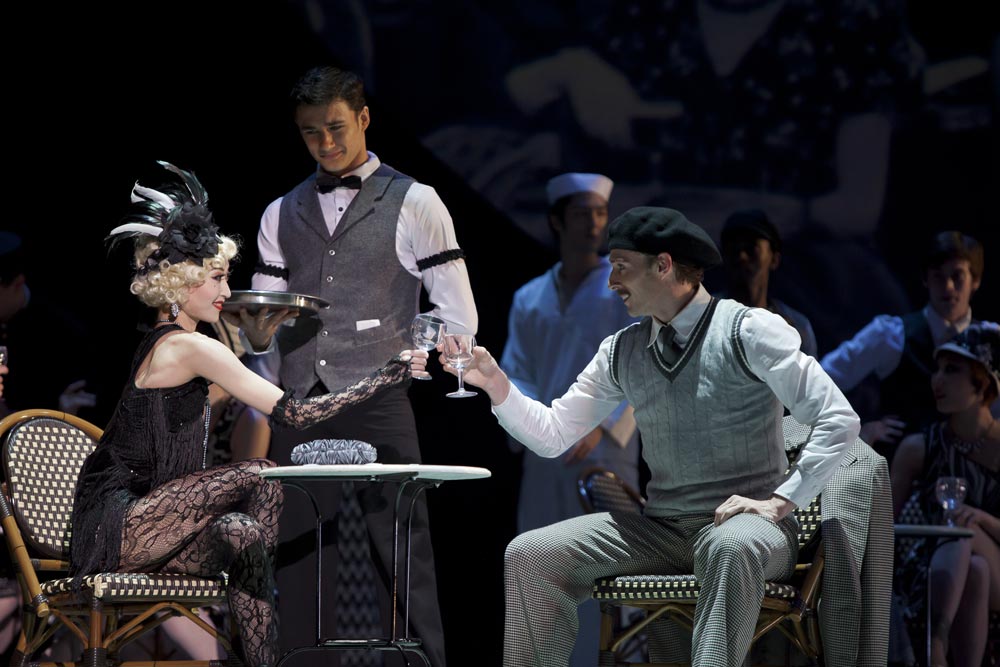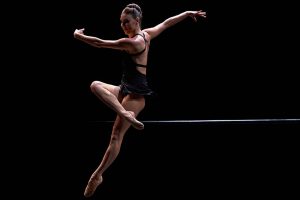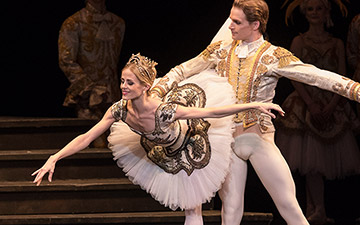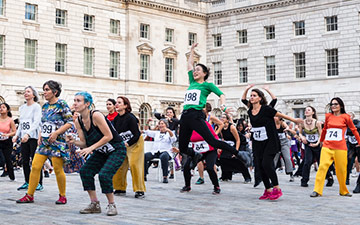
© Brianne Bland. (Click image for larger version)
The Washington Ballet
Hemingway: The Sun Also Rises
Washington, Kennedy Center Eisenhower Theater
10 May 2013
www.washingtonballet.org
www.kennedy-center.org
It takes unbound imagination and a certain nerve to re-imagine Ernest Hemingway’s celebrated novel, “The Sun Also Rises,” with its terse dialogues, colorful personages, and vivid evocations of Paris and Spain in the 1920s, into a two-hour ballet. Washington Ballet Artistic Director Septime Webre, however, is just that creative and brave. His ballet, Hemingway: The Sun Also Rises, sets into motion Hemingway’s exploration of the discontent, cynicism and moral decay of the post-World War I generation, which in turn serves as a backdrop to a twisted love saga between the novel’s main characters –wounded American journalist Jake Barnes and the alluring and impulsive socialite Lady Brett Ashley.
Hemingway was a young unknown writer when, in 1926, he published his first novel, with an eloquent title he took from Ecclesiastes: “… The sun also ariseth, and the sun goeth down, and hasteth to the place where he arose…” (He gave the whole quotation as the epigraph to the book, juxtaposing it with the famous phrase with which Gertrude Stein christened the young people who served in the First World War, “You are all the lost generation.”) Immediately after the novel was published, Hemingway became a star, praised for his “lean, hard, athletic narrative prose that puts more literary English to shame” and for his “most admirable dialogues.” Nearly 90 years later, “The Sun Also Rises” is still relevant and most worthy of reading, for the book masterfully captures the universal theme of emotional pain and frustration of all the generations ever deemed “lost.”
“The Sun Also Rises” has inspired a number of reincarnations in a variety of genres. It was adapted for the big screen in 1957 and turned into a TV miniseries in 1984. There are multiple theater adaptations of the book. In 2000, the Long Island Opera Company presented the world premiere of the one-act opera “The Sun Also Rises” created by American composer Webster Young. Webre’s new ballet is a first stab at putting Hemingway’s classic en pointe.
“The Sun Also Rises” doesn’t have to be your favorite book to truly enjoy and appreciate this smart, vibrant and hugely entertaining production, which the Washington Ballet premiered at the Kennedy Center’s Eisenhower Theater during the second week of May. The new ballet is a vivid example of how words from a novel can make the journey into potent dance-theater by a skillful merger of multiple genres, including live jazz, written prose, film, photography and fashion to bring to life Hemingway’s evocative tale of tarnished dreams and unfulfilled love.

© Brianne Bland. (Click image for larger version)
The new production succeeds on many levels and demonstrates once again that Webre has a knack for choosing a winning team of collaborators. The ballet’s scenario was a joint venture of Webre and award-winning playwright Karen Zacarias. Never losing sight of the dramatic aspects of the novel, the librettists faithfully followed its narrative, incorporating into the ballet’s two acts nearly all the major scenes of the book. The story is told in restrained, concise manner to mirror Hemingway’s laconic writing style.
Billy Novick’s jazzy, light-hearted score – his original compositions and arrangements – give the ballet the authentic sound and rhythmic flavor of the Parisian atmosphere during Les Années Folles (the Roaring Twenties) and the traditional Spanish fiesta. The music was performed live, with Novick himself in the orchestra pit, playing saxophone and clarinet. (The Sun Also Rises is the second collaboration between Webre and Novick. Their first page-to-stage ballet, The Great Gatsby was premiered by the Washington Ballet in 2010 to wide acclaim.)
Hugh Landwehr’s imaginative scenery and props aptly recreated the spirit of the time and helped move the intricate plot forward. The costume designer, Helen Q. Huang, outfitted the production with style, wit and imagination. Demonstrating keen grasp of the material detail, Webre, in turn, crated a fascinating choreographic language, carefully molding each character of the story and vividly rendering the atmosphere of the novel’s multiple locales.
The ballet’s first act is set in Paris in the 1920s and follows a group of young expatriates, living carefree lives of alcohol and pleasure. The story centers on Jake Barnes (Jared Nelson), an American newspaper journalist and veteran of WWI, who is left sexually impotent and emotionally damaged by war injuries. The central tragedy of the story is Jake’s inability to be with the woman he deeply loves.
As the curtain rises, we see Jake laboring at the typewriter in his tiny, stark apartment. As he types, snippets of his writing are shown on white panels above the stage. So, in a way, Jake becomes the ballet’s silent narrator; and the displayed written prose, most of which is directly quoted from the novel, serves as a clever device to introduce the new characters and give the audience better understanding of the complex narrative.
Early in Act I we meet Robert Cohn (Corey Landolt) and his girlfriend Frances (Emily Ellis). A Princeton-educated aspiring writer with a special affinity for boxing, Cohn, who once was head-over-hills about Frances, is no longer in love with her. As we learn from the surtitles, she, on the other hand, “found toward the end of the second year that her looks were going” and “her attitude toward Robert changed from one of careless possession and exploitation to the absolute determination that he should marry her.” Their little choreographic number perfectly underscores the contradictory feelings the couple experience toward each other.
As the story progresses, the action spills onto the crowded streets and bars of Paris by way of a mural-size display of period photography and film, with images of Parisian landmarks projected on the backdrop.

© Brianne Bland. (Click image for larger version)
At one of many bars the lonely Jake picks up a harlot, Georgette Leblanc (Maki Onuki), “because of a vague sentimental idea that it would be nice to eat with someone.” They dance an alluring duet during which Georgette tries to seduce Jake. To her apparent surprise and dismay, he firmly declines her advances. Their printed dialogue appears above the stage. Georgette: “What’s the matter, can’t you get it up?” Jake: “Well… I can’t. I got hurt in the war.” This scene renders one of the most poignant images of the ballet – Jake both openly admitting and accepting his disability. This moment was artfully captured by the creators as well as the dancers.
When the irresistible Lady Brett Ashley (Sona Kharatian) makes her glamorous entrance during a big swinging party at a bar, it seems like everything and everyone fades away. She is a remarkably beautiful woman, “built with curves like the hull of a racing yacht.” She is also a sexual dynamo. She attracts men like a magnet and changes them like white gloves. After each ceased relationship, she comes back to Jake, who is always there for her. Because of Jake’s injury, their erotic attraction is destined to be unfulfilled; and as a result, Jake goes through his life witnessing Brett’s amorous escapades with unspoken, yet painful, acceptance. Their unconventional bond is sublimely expressed in their duets, which come across as tender and caring rather than sexual.

© Brianne Bland. (Click image for larger version)
Webre and his team do a tremendous job at getting the story going. The first act swiftly winds its way from one location to the next thanks to the simple and clever sets, which almost instantly transform the stage, taking the audience from Parisian night life to Jake’s apartment, to a WWI battlefield, to a hospital room where the wounded Jake first met Brett, who was a nurse during the war. There is also a boxing studio match, after which we are transported to a wild party at the Lido.
The Parisian part of the ballet turned out to be the real gem. The stage decor and costumes here are rendered in a black-and-white palette. More often than not, I felt I was watching part ballet, part silent movie accompanied by a fantastic jazz band and witty subtitles. The large ensemble dances in bar scenes, including a feisty cancan sequence at the end, were fittingly rambunctious and zesty, exuding the air of endless frivolity and glee. The acting and dancing by the principal cast exceeded all my expectations.
Webre, as he has done in his previous productions, invited a number of guest artists whose star power helped ignite the show all the more. In one unforgettable moment, jazz diva E. Faye Butler brought the house down with a show-stopping number, “You Gotta Give Me Some.” With her unique throbbing vocals and winning personality, flanked by a smashingly handsome Luis R. Torres in the role of a Greek aristocrat with an unpronounceable name, Ms. Butler shimmied her way right into the audience’s hearts.
Act II takes us to Spain. Unlike the gray-scaled first act, the scenery and costumes here burst with color. In the beginning, Webre conjures a fascinating fishing scene, with Jake and his war buddy, Bill Gorton, relaxing at the Irati River in Burguete. There is a witty pas de deux in which the two friends perform juggling their fishing rods and wine bottles. Set against a projected image of calm waters and accompanied by cool jazz, this mesmerizing episode yields a starkly contrasted mood from the bubbly Act I.

© Brianne Bland. (Click image for larger version)
Then the tranquility is all gone when a vibrant procession of Spanish villagers, celebrating the beginning of the Fiesta, enters the stage. From that point forward, however, the ballet seems to be running out of steam. Although the wild spirit of Spanish fiesta (or “the running of the bulls”) is aptly captured by means of period film footage, the rest of the second act’s choreography falls short in the narration, and the culminating scenes of the production feel rushed.
A good-looking 19-year old bullfighter, Pedro Romero (Brooklyn Mack) is given a disappointingly ordinary sequence of jumps and pirouettes. His love affair with Brett is only roughly sketched and the handsome toreador comes across merely as another casualty of Brett’s fickle sexual appetite.
Still, Webre saves the best for last. If the bullfighting scene is far from thrilling, watching the bare-knuckle boxing brawl in the end of the ballet, instigated by the disgruntled Robert Cohn, is worth the price of admission alone. At one point, I feared bloodshed. This scene alone would have made Hemingway proud.

















You must be logged in to post a comment.